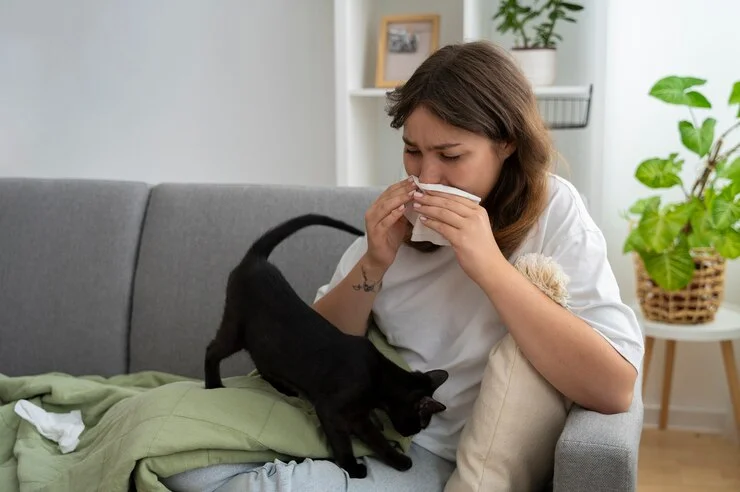-
Kutchina service center, Kolkata - 700010
Kutchina service center, Kolkata - 700010

Learn how to identify the symptoms of allergies in pets and understand their causes and treatment. Know when to seek help from one of the Best Pet Clinics for proper care and treatment for your pet.

Allergy Symptoms in Pets can be a frustrating and worrying condition for both pet owners and their furry companions. Just like humans, pets can suffer from allergic reactions to a range of environmental triggers, food ingredients, and other substances. These allergies can cause discomfort and distress to the animal, making it vital for pet owners to recognize the symptoms early on. By identifying the signs of Allergy Symptoms in Pets, owners can ensure that their pets receive the right care and treatment to reduce discomfort.
In this article, we will dive into the common symptoms of Allergy Symptoms in Pets, discuss the different causes of allergic reactions, and provide practical tips for managing these allergies. We will also explore when it is time to seek professional help from a renowned Pet Clinic for diagnosis and treatment. By the end of this post, you will have a deeper understanding of Allergy Symptoms in Pets and how to improve your pet’s well-being.
Allergy Symptoms in Pets can be triggered by a variety of factors. Understanding the underlying causes is crucial for diagnosing and managing these allergic reactions effectively.
Environmental allergens are among the most common triggers of allergic reactions in pets. Pets, especially dogs and cats, may be sensitive to various substances in their environment, including:
Pets, especially dogs and cats, can also develop food allergies. These allergies often develop over time and can be difficult to diagnose without a professional evaluation. Common food allergens include:

Recognizing the symptoms of allergies in pets is essential for timely intervention and treatment. While many symptoms overlap with other health conditions, certain signs can help you identify if your pet is suffering from allergies.
One of the most noticeable symptoms of allergies in pets is itching and skin irritation. Pets may start scratching, licking, or biting at certain areas of their body, particularly their paws, ears, and belly. Some common skin-related signs of allergies include:
Just like humans, pets can develop respiratory problems as a result of environmental allergens. Common signs of respiratory issues caused by allergies include:
Food allergies in pets often manifest through digestive issues. Symptoms related to food allergies include:
Ear infections are commonly associated with allergies in pets, especially when the allergies are caused by environmental factors like pollen or dust mites. Symptoms of ear infections include:
Pets suffering from allergies may exhibit behavioral changes due to the discomfort they experience. Some common behavioral signs of allergies include:
While allergic Conditions in Pets can’t always be cured, there are several ways to manage the symptoms and improve your pet’s comfort. The right treatment plan can make a significant difference in your pet’s quality of life.
The first step in managing allergies in pets is to consult a veterinarian. If you notice any symptoms of allergies, it is crucial to seek professional advice to accurately diagnose the issue. Your vet can help you identify whether the allergy is food-related or environmental and will provide recommendations for effective treatments.
In some cases, your veterinarian may recommend allergy testing to pinpoint the specific allergens causing your pet’s symptoms. Allergy testing can be done through skin tests or blood tests and will allow your vet to tailor a treatment plan specific to your pet’s needs.
There are various medications and treatments available to help manage allergies in pets. Some common treatments include:
Managing the environment is crucial in reducing allergens for pets with environmental allergies. Some helpful tips include:
If your pet’s allergies are food-related, switching to a hypoallergenic diet may help alleviate symptoms. Consult your vet for dietary recommendations that can help manage food allergies.

While allergic Conditions in Pets cannot be cured, they can be managed with proper care. A combination of medication, environmental management, and dietary changes can help reduce symptoms.
If your pet’s allergies seem to flare up after eating, it could be a food-related allergy. Your vet can perform tests to determine the specific allergens and recommend an appropriate diet.
While it’s difficult to completely prevent allergic Conditions in Pets, reducing exposure to known allergens and maintaining a clean environment can help minimize allergic reactions.
Recognizing the symptoms of Allergic Conditions in Pets and understanding how to manage them is essential for keeping your pet comfortable and healthy. Whether the allergies are food-related or environmental, taking the right steps to address the issue can significantly improve your pet’s well-being. Consulting a Best Pet Clinic in Kolkata for diagnosis and treatment is the best way to ensure your pet receives the appropriate care.
By being vigilant and proactive, you can help your furry companion live a more comfortable and happy life, free from the discomfort of allergies. Always remember that with the right care and attention, most pets can lead a long and healthy life, even with allergies.